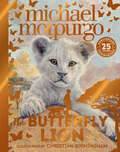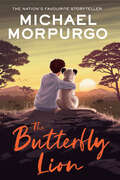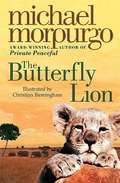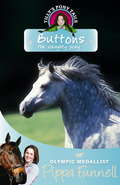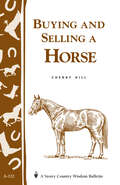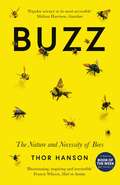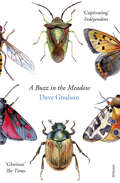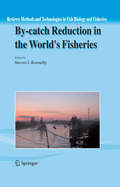- Table View
- List View
Butterfly lifecycle 3 (pupa) (UEB Uncontracted)
The pupa has its head to the right of the page and the tail end to the left. At the bottom of the page is a scale. There is a locator dot shown, which will be at the top left of the page when the image is the right way up. In the right centre of the image the circular shape of the covered eye can be found. Down from this is a covered antenna which goes left to the centre of the pupa. The large triangular area on the right of the pupa is where the wing is developing. The left half of the pupa is its developing abdomen with a small spiracle in the centre of each segment allowing it to breathe. Towards the top of each segment is a small decorative golden stud.
Butterfly lifecycle 4 (adult emerges from pupa) (Large Print)
This image shows an opened pupa hanging on the left and in the centre of the page is the recently emerged adult hanging onto the right side of the pupa. There is a locator dot shown, which will be at the top left of the page when the image is the right way up. Its head is in the top centre and the tail in the bottom centre of the page. They are surrounded by an image border. The empty casing of the pupa hangs head down with the bottom half opened up. At the top centre of the page is the end of one of the adult's two antennae, it is still soft from being in the pupa and has not yet straightened and stiffened. To the left of the base of the antenna one of its two large eyes is showing on its head. Down from the head is the thorax with two of its four wrinkled wings sticking out to the right. The upper, larger fore wing has an orange band in the middle and two white spots in the top centre. The smaller hind wing is down from this and has an orange edge on the right. Three of its six multi-jointed legs are to the left of the abdomen, which it uses to hold onto the pupa. Down from this is the segmented abdomen.
Butterfly lifecycle 4 (adult emerges from pupa) (UEB Contracted)
This image shows an opened pupa hanging on the left and in the centre of the page is the recently emerged adult hanging onto the right side of the pupa. There is a locator dot shown, which will be at the top left of the page when the image is the right way up. Its head is in the top centre and the tail in the bottom centre of the page. They are surrounded by an image border. The empty casing of the pupa hangs head down with the bottom half opened up. At the top centre of the page is the end of one of the adult's two antennae, it is still soft from being in the pupa and has not yet straightened and stiffened. To the left of the base of the antenna one of its two large eyes is showing on its head. Down from the head is the thorax with two of its four wrinkled wings sticking out to the right. The upper, larger fore wing has an orange band in the middle and two white spots in the top centre. The smaller hind wing is down from this and has an orange edge on the right. Three of its six multi-jointed legs are to the left of the abdomen, which it uses to hold onto the pupa. Down from this is the segmented abdomen.
Butterfly lifecycle 4 (adult emerges from pupa) (UEB Uncontracted)
This image shows an opened pupa hanging on the left and in the centre of the page is the recently emerged adult hanging onto the right side of the pupa. There is a locator dot shown, which will be at the top left of the page when the image is the right way up. Its head is in the top centre and the tail in the bottom centre of the page. They are surrounded by an image border. The empty casing of the pupa hangs head down with the bottom half opened up. At the top centre of the page is the end of one of the adult's two antennae, it is still soft from being in the pupa and has not yet straightened and stiffened. To the left of the base of the antenna one of its two large eyes is showing on its head. Down from the head is the thorax with two of its four wrinkled wings sticking out to the right. The upper, larger fore wing has an orange band in the middle and two white spots in the top centre. The smaller hind wing is down from this and has an orange edge on the right. Three of its six multi-jointed legs are to the left of the abdomen, which it uses to hold onto the pupa. Down from this is the segmented abdomen.
Butterfly lifecycle 5 (adult fills and dries wings) (Large Print)
This image shows the butterfly viewed from the side with its head on the right and its tail on the left. There is a locator dot shown, which will be at the top left of the page when the image is the right way up. On the right one of its two large eyes is showing with one of its two antennae above it. To the left of the head is the thorax with two of its four wings sticking up. To the right is the fore wing with two patches of orange in the centre and up from them, two white spots. The hind wing is to the left, it has a silver spot near the thorax and a grey band on the edge to the left. The wings are still soft bags which will flatten as the veins fill and stretch them flat and hard. Left from this is the segmented abdomen. Three of its six multi-jointed legs can be found, upon which it stands.
Butterfly lifecycle 5 (adult fills and dries wings) (UEB Contracted)
This image shows the butterfly viewed from the side with its head on the right and its tail on the left. There is a locator dot shown, which will be at the top left of the page when the image is the right way up. On the right one of its two large eyes is showing with one of its two antennae above it. To the left of the head is the thorax with two of its four wings sticking up. To the right is the fore wing with two patches of orange in the centre and up from them, two white spots. The hind wing is to the left, it has a silver spot near the thorax and a grey band on the edge to the left. The wings are still soft bags which will flatten as the veins fill and stretch them flat and hard. Left from this is the segmented abdomen. Three of its six multi-jointed legs can be found, upon which it stands.
Butterfly lifecycle 5 (adult fills and dries wings) (UEB Uncontracted)
This image shows the butterfly viewed from the side with its head on the right and its tail on the left. There is a locator dot shown, which will be at the top left of the page when the image is the right way up. On the right one of its two large eyes is showing with one of its two antennae above it. To the left of the head is the thorax with two of its four wings sticking up. To the right is the fore wing with two patches of orange in the centre and up from them, two white spots. The hind wing is to the left, it has a silver spot near the thorax and a grey band on the edge to the left. The wings are still soft bags which will flatten as the veins fill and stretch them flat and hard. Left from this is the segmented abdomen. Three of its six multi-jointed legs can be found, upon which it stands.
Butterfly lifecycle 6 (Adult) (Large Print)
This image shows the butterfly viewed from above. Its body is in the centre of the page with the head at the top of the page. There is a locator dot shown, which will be at the top left of the page when the image is the right way up. There is a scale at the bottom of the page. In the top centre of the image are the tips of two antennae which stretch down to the head. It has two large eyes showing with two antennae stretching out above it. Down from the head is the thorax with two wings to the left and right. The fore wings in the top half of the page have an orange band in the middle. The wing tips to the left and right have bright white patches and spots. The hind wings have a band of orange on the outer edge to the left and right. All wings have tiny patches of white on the edge in places and some small patches of blue near the edges but these are too small to be seen on the tactile image. Down from this is the segmented abdomen. The legs are not shown.
Butterfly lifecycle 6 (Adult) (UEB Contracted)
This image shows the butterfly viewed from above. Its body is in the centre of the page with the head at the top of the page. There is a locator dot shown, which will be at the top left of the page when the image is the right way up. There is a scale at the bottom of the page. In the top centre of the image are the tips of two antennae which stretch down to the head. It has two large eyes showing with two antennae stretching out above it. Down from the head is the thorax with two wings to the left and right. The fore wings in the top half of the page have an orange band in the middle. The wing tips to the left and right have bright white patches and spots. The hind wings have a band of orange on the outer edge to the left and right. All wings have tiny patches of white on the edge in places and some small patches of blue near the edges but these are too small to be seen on the tactile image. Down from this is the segmented abdomen. The legs are not shown.
Butterfly lifecycle 6 (Adult) (UEB Uncontracted)
This image shows the butterfly viewed from above. Its body is in the centre of the page with the head at the top of the page. There is a locator dot shown, which will be at the top left of the page when the image is the right way up. There is a scale at the bottom of the page. In the top centre of the image are the tips of two antennae which stretch down to the head. It has two large eyes showing with two antennae stretching out above it. Down from the head is the thorax with two wings to the left and right. The fore wings in the top half of the page have an orange band in the middle. The wing tips to the left and right have bright white patches and spots. The hind wings have a band of orange on the outer edge to the left and right. All wings have tiny patches of white on the edge in places and some small patches of blue near the edges but these are too small to be seen on the tactile image. Down from this is the segmented abdomen. The legs are not shown.
The Butterfly Lion (Collector's Edition Ser.)
by Michael MorpurgoCelebrating the twenty-fifth anniversary of the stunning, classic story of an unforgettable friendship with a glorious colour gift edition, fully illustrated by Christian Birmingham.
The Butterfly Lion (Collectorâs Edition Ser.)
by Michael MorpurgoILLUSTRATED BY CHRISTIAN BIRMINGHAM.A lyrical and moving tale of a young boy growing up in Africa, and his lifelong friendship with a white lion.
The Butterfly Lion
by Michael Morpurgo Christian BirminghamILLUSTRATED BY CHRISTIAN BIRMINGHAM. A lyrical and moving tale of a young boy growing up in Africa, and his lifelong friendship with a white lion. "All my life I'll think you you, I promise I will. I won't ever forget you. " Bertie rescues an orphaned white lion cub from the African veld. They are inseparable until Bertie is sent to boarding school far away in England and the lion is sold to a circus. Bertie swears that one day they will see one another again, but it is the butterfly lion which ensures that their friendship will never be forgotten.
The Butterfly Lion (PDF)
by Michael MorpurgoA lyrical and moving tale of a young boy growing up in Africa, and his lifelong friendship with a white lion. “All my life I’ll think you you, I promise I will. I won’t ever forget you.” Bertie rescues an orphaned white lion cub from the African veld. They are inseparable until Bertie is sent to boarding school far away in England and the lion is sold to a circus. Bertie swears that one day they will see one another again, but it is the butterfly lion which ensures that their friendship will never be forgotten.
Buttons the Naughty Pony: Book 14 (Tilly's Pony Tails #14)
by Pippa FunnellMeet Tilly Redbrow, who doesn't just love horses - she lives, breathes and dreams them too! Naughty pony Buttons is coming to Silver Shoe Farm because his owner, Tim, just doesn't know what to do with him. They need Tilly's help - and fast! From Pony Club to riding for the British team, and for every girl who has ever longed for a pony of her own, these delightful, warm and engaging stories are packed with Pippa Funnell's expert advice on everything you ever wanted to know about horses.
Buttons the Naughty Pony (Pippa's Pony Tales #14)
by Pippa FunnellTilly dreams of having a pony of her own. One that only she can ride to stardom. Will her wishes come true when she joins Silver Shoe Farm Stables?Oh Buttons, what a naughty pony! He's disobedient for everyone at Silver Shoe Farm, until he meets Tilly. She has some clever ideas for turning this tricky pony into a happy pony.Collect all 18 titles in this series of irresistible, uplifting and heartwarming pony adventures. Printed in a dyslexia friendly font and packed with up to date tips from three times Olympic Medallist, Pippa Funnell, as well as a helpful glossary and black and white illustrations on every spread.
Buying and Selling a Horse: Storey's Country Wisdom Bulletin A-122 (Storey Country Wisdom Bulletin)
by Cherry HillSince 1973, Storey's Country Wisdom Bulletins have offered practical, hands-on instructions designed to help readers master dozens of country living skills quickly and easily. There are now more than 170 titles in this series, and their remarkable popularity reflects the common desire of country and city dwellers alike to cultivate personal independence in everyday life.
Buzz: The Nature and Necessity of Bees
by Thor HansonBBC RADIO 4 BOOK OF THE WEEK 'Popular science at its most accessible: fun, fascinating and full of engaging pen portraits of the scientists and bee enthusiasts he meets in the course of his research' Melissa Harrison, Guardian 'A smooth and accessible account of the insects that provide a significant amount of what we eat, introducing their fascinating diversity of behaviour. A reminder of why bees are wonders that we must protect.' Matt Shardlow, BBC Wildlife Bees are like oxygen: ubiquitous, essential, and, for the most part, unseen. While we might overlook them, they lie at the heart of relationships that bind the human and natural worlds. In Buzz, the award-winning author of Feathers and The Triumph of Seeds takes us on a journey that begins 125 million years ago, when a wasp first dared to feed pollen to its young. From honeybees and bumbles to lesser-known diggers, miners, leafcutters, and masons, bees have long been central to our harvests, our mythologies, and our very existence. They’ve given us sweetness and light, the beauty of flowers, and as much as a third of the foodstuffs we eat. And, alarmingly, they are at risk of disappearing. As informative and enchanting as the waggle dance of a honeybee, Buzz shows us why all bees are wonders to celebrate and protect. Read this book and you'll never overlook them again.
The Buzz about Bees: Biology of a Superorganism
by Jürgen TautzTis book, already translated into ten languages, may at frst sight appear to be just about honeybees and their biology. It c- tains, however, a number of deeper messages related to some of the most basic and important principles of modern biology. Te bees are merely the actors that take us into the realm of phys- ology, genetics, reproduction, biophysics and learning, and that introduce us to the principles of natural selection underlying the evolution of simple to complex life forms. Te book destroys the cute notion of bees as anthropomorphic icons of busy self-sacr -i fcing individuals and presents us with the reality of the colony as an integrated and independent being—a “superorganism”—with its own, almost eerie, emergent group intelligence. We are s- prised to learn that no single bee, from queen through drone to sterile worker, has the oversight or control over the colony. - stead, through a network of integrated control systems and fee- backs, and communication between individuals, the colony - rives at consensus decisions from the bottom up through a type of “swarm intelligence”. Indeed, there are remarkable parallels between the functional organization of a swarming honeybee colony and vertebrate brains.
A Buzz in the Meadow: The Natural History Of A French Farm
by Dave GoulsonFrom the author of the Samuel Johnson Prize-shortlisted Sunday Times bestseller A Sting in the TaleIn 2003 Dave Goulson bought a derelict farm in the heart of rural France, together with 33 acres of surrounding meadow. Over the course of a decade, he created a place for his beloved bumblebees to thrive along with myriad insects of every kind. In this book you will learn how a deathwatch beetle finds its mate, about the importance of houseflies, why butterflies have spots on their wings, about dragonfly sex, bed-bugs and wasps. But it is also a wake-up call, urging us to cherish and protect life on earth in all its forms. A Buzz in the Meadow is a captivating look at our natural world and a call to arms for nature-lovers everywhere.‘Glorious’ The Times ‘Captivating’ Independent
Buzzard (Large Print)
This is a picture of a Buzzard shown from the side, with its head facing to the left of the page. There is a locator dot shown, which will be at the top left of the page when the image is the right way up. It has a sharp, downward curving beak, and one eye is visible. Down and to the right of this are the Buzzard's body and wing, and down from this, its legs with formidable curved talons. To the right is its tail. The colour of the Buzzard is usually light brown. The wing, to the right of the page, is a darker shade of brown.
Buzzard (UEB Contracted)
This is a picture of a Buzzard shown from the side, with its head facing to the left of the page. There is a locator dot shown, which will be at the top left of the page when the image is the right way up. It has a sharp, downward curving beak, and one eye is visible. Down and to the right of this are the Buzzard's body and wing, and down from this, its legs with formidable curved talons. To the right is its tail. The colour of the Buzzard is usually light brown. The wing, to the right of the page, is a darker shade of brown.
Buzzard (UEB Uncontracted)
This is a picture of a Buzzard shown from the side, with its head facing to the left of the page. There is a locator dot shown, which will be at the top left of the page when the image is the right way up. It has a sharp, downward curving beak, and one eye is visible. Down and to the right of this are the Buzzard's body and wing, and down from this, its legs with formidable curved talons. To the right is its tail. The colour of the Buzzard is usually light brown. The wing, to the right of the page, is a darker shade of brown.
By-catch Reduction in the World's Fisheries (Reviews: Methods and Technologies in Fish Biology and Fisheries #7)
by Steven J. KennellyWith by-catch in fisheries becoming an ever more high-profile problem, this brilliant work could not be more timely. It contains contributions from the world’s leading experts in by-catch reduction, who guide the reader through most aspects of the field. They examine the methodologies used to develop by-catch reduction techniques and provide new avenues for broadening such work. Case studies are provided that encompass most of the world’s fishing techniques and regions.
C. elegans: Methods and Applications (Methods in Molecular Biology #1327)
by David Biron and Gal HaspelThe aim of this volume is to provide a step-by-step guide for implementing a selection of novel techniques in the lab. Each protocol in this volume is presented as a standalone chapter, specifically geared towards addressing practical needs without presuming prior knowledge of the technique at hand. Written in the highly successful Methods in Molecular Biology series format, chapters include introductions to their respective topics, lists of the necessary materials and reagents, readily reproducible laboratory protocols, and key tips on troubleshooting and avoiding known pitfalls.Authoritative and practical, C. elegans: Methods and Applications, Second Edition aims to ensure successful results in the further study of this dynamic field.

